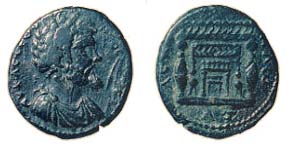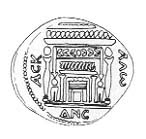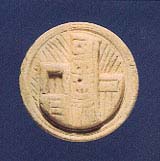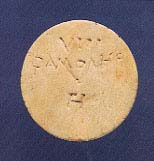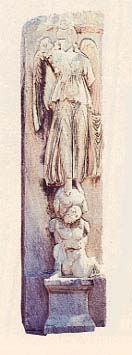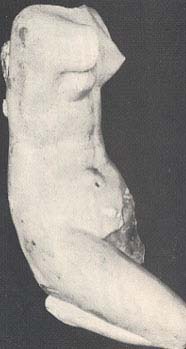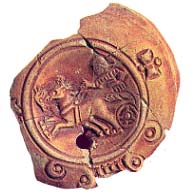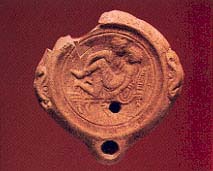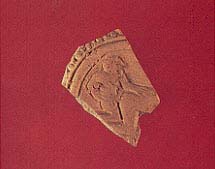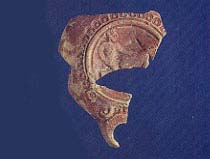This is part III of a three-part article. Part II appeared in the last issue (“Why Were Hundreds of Dogs Buried at Ashkelon?” BAR 17:03).

Throughout most of its 5,000-year history, Ashkelon’s fortunes and destiny were tied to the sea. As a major Mediterranean seaport, it was a commercial and cultural center. From the highlands to the east, a cornucopia of produce and products flowed down to its warehouses before shipment to other ports around the Mediterranean. Olive oil, wine, timber, resin, meat, hides, wool, limestone and chalk, handicrafts and textiles were some of the commodities from the hinterland. The nearby plains and major valleys were breadbaskets for wheat, some of which was also exported through Ashkelon. From the immediate vicinity of the city, fish, wine, garden crops and textiles were, in different periods, part of the local export.
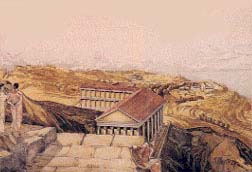
In return special wines, oils, perfumes, pottery, precious metals, such as silver and especially gold, were imported from distant lands. Some of these imported items were then exchanged farther inland. No doubt much of the profit that accrued from this international exchange went into the coffers of the big-time import-export merchants of Ashkelon, who sat astride the major sea-lanes and overland routes and who were the only ones really to know the price differentials between the point of production and the point of final sale at some faraway port. This oligarchy of merchants exercised economic power through the knowledge of supply and demand and gave definition to what was real “port power.”
Throughout its history as a seaport, Ashkelon was also a center for intellectual exchange, for the flow of ideas and for the intermingling of different customs and of a variety of languages.
In addition to providing commercial and intellectual exchange, seaports also provided a center for the transmission of disease. Ships carried plagues and epidemics along with their precious cargoes. The sailor’s delight—wine, women and song—promoted and encouraged the spread of social diseases as well. It is not so surprising to find healing cults, such as we associated with deities and dogs in the last issue, located at portside in fifth-century B.C. harbor towns like Ashkelon and like Kition on Cyprus. As we have already seen, a succession of peoples and cultures dominated life in Ashkelon throughout the Bronze and Iron Ages—the Canaanites, followed by the Philistines, and then by the Phoenicians. Foreign merchants, some perhaps living in mercantile enclaves or quarters within the city, added to the variety. In this issue, we will examine the effects of Hellenization on local cultures, the persistence of older customs and ideas along with the introduction of new ones. Then we will examine the relationships of Greco-Romans (pagans), Jews, Christians and Moslems, as powerful new ideas and ideologies vie for the soul of ancient Ashkelon during its last 1,000 years.
By 147 B.C., the Jews, under the leadership of Judas Maccabeus and his brothers, successfully I revolted against their Syrian overlords, the Seleucids, and established a line of succession known as the Hasmonean dynasty. But the war I had not yet ended. Apollonius, the Seleucid I governor, led a powerful army encamped near I the Mediterranean coast not far from the old territory of Philistia. Jonathan, one of the Maccabean brothers who by then not only was the secular leader of the new Jewish nation (the Second Commonwealth) but had also taken the title of high priest, led a force of thousands to challenge Apollonius’ army on the coastal plain. When Jonathan’s forces routed the Seleucid forces, Apollonius’ men fled to the old Philistine town of Ashdod, then known as Azotus. Jonathan pursued them; he “burned and plundered Azotus with its neighboring towns, and destroyed by fire both the temple of Dagon [the old Philistine god] and the men who had taken refuge in it” (1 Maccabees 10:84).
To avert a similar disaster, the people of nearby Ashkelon “came out to meet Jonathan] with great pomp.” Ashkelon thus escaped destruction. Jonathan and his army then returned to Jerusalem “laden with much booty,” some of which came from Ashkelon (1 Maccabees 10:86–87; see also 1 Maccabees 11:60).
Ashkelon had a knack for maintaining its autonomy. True, when Alexander the Great conquered the Levant in about 332 B.C., Ashkelon, like most of the then-known world, became part of his empire. On Alexander’s death in 323 B.C., his empire split in two—the Seleucids of Syria in the north and the Ptolemies of Egypt in the south claiming different parts of it. The Ptolemies ruled Ashkelon until 198 B.C. Then it was the Seleucids’ turn. But throughout the Maccabean period (152–37 B.C.), Ashkelon retained its autonomy. Indeed, Ashkelon was able to maintain its autonomy throughout the Roman period (37 B.C.–324 A.D.) as well.
From about 375 B.C. to 235 A.D., Ashkelon issued coins almost continuously (see “Eroticism and Infanticide at Ashkelon,” for examples). Bronze and silver coins were minted there during both Ptolemaic and Seleucid rule. During the first century B.C., Ashkelon minted its own silver shekels.
Culturally, like the other cities along the Mediterranean coast, Ashkelon underwent a process of Hellenization in which Greek language, conventions and institutions prevailed. The effects of Alexander’s conquest were long-lasting and essentially irreversible. Yet, despite the Hellenistic overlay, the older substratum of Phoenician culture that we described in the BAR 17:03 was never totally eradicated (see “Why Were Hundreds of Dogs Buried at Ashkelon?”).
In the first century B.C., Ashkelon’s silver shekels bore the dove, symbol of Tyche-Astarte (the Greco-Roman and Phoenician goddess) and symbol of the autonomous city mint. The inscription was in Greek. It read: “Of the people of Ascalon, holy, city of asylum, autonomous.”1
Ashkelon not only had the most active mint in Palestine; the city was also an important banking center. We even know the name of one of its prominent bankers, a certain Philostratus.2
As we have already noted, for much of its history, Ashkelon’s prosperity was based mainly on its importance as a seaport. The famous Letter of Aristeasa (c. 150 B.C.) mentions Ashkelon along with Joppa, Gaza and Ptolemais (Acco) as Mediterranean harbors “well placed to serve trade.”3 That Ashkelon was a great emporium of commodities as well as a center of exchange during the entire Greco-Roman era is nicely illustrated in a cistern we excavated in the basement of what had once been an impressive villa (Grid 38 [upper]). The cistern went out of use sometime in the last half of the second century B.C. The discarded tableware found in the cistern included fine ceramic imports from Greece and the island of Chios. Also discarded in the cistern when the villa was abandoned were transport amphorae, which were once filled with wines from Rhodes and Italy.
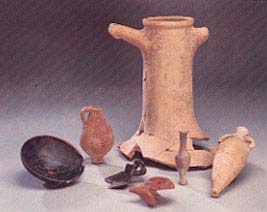
Ashkelon was not only an emporium of commodities, it was also an emporium of ideas. One of its sons, a certain Antiochus (born in about 125 B.C.), became head of the prestigious philosophical Academy in Athens, where he tried to reconcile the philosophies of Plato, Aristotle and the Stoics.4 Other philosophers, rhetoricians, orators and grammarians taught in the schools of Ashkelon and Gaza. Dorotheus of Ashkelon compiled a lexicon of Attic Greek. Several Ashkelonites were honored abroad in Italy and Greece, as we know from inscriptions found in such distant places as Naples, Puteoli, Athens and Delos.5
Herod the Great displaced the Hasmonean dynasty of Judea in 37 B.C. He ruled until 4 B.C., but the so-called Herodian period lasted until 70 A.D. when the Romans destroyed Jerusalem. According to one tradition, Herod was born in Ashkelon; his grandfather is said to have been a servant in the temple of Apollo at Ashkelon.6
When Herod became king, he bestowed great honors upon his birthplace by building “baths and ornate fountains for the population of Ascalon, with colonnades [Greek, peristula] remarkable for their workmanship and size.”7 Herod also built a palace in Ashkelon for Emperor Augustus. Upon Herod’s death, Augustus bestowed it upon Herod’s sister, Salome.8
The British archaeologist John Garstang, who excavated at Ashkelon in the 1920s, thought he had found Herod’s colonnades (Garstang called it the peristyle-colonnades, or cloisters) adjoining what Garstang called the bouleuterion, or Senate Hall (located in Grids 40 and 47). We consider these to be a single building; because we date it to the second or third century A.D., however, we will consider this building a bit later.
In the southeast corner of the city is a puzzling circular depression. According to tradition, which persisted among Arabs into the 20th century, this circular depression is Bir Ibrahim, or the Wells of Abraham (also called the Well of Abraham). As our staff geologist and polymath, Professor Frank Koucky of Wooster College, was the first to observe, this circular depression is stepped. It is in fact the impression of an ancient theater. The steps indicate where tiers of marble seats were once set. Not far from the theater, Koucky located an upended, carved block of marble, which looked very much like an ancient theater seat as it lay there on the green grass of one of the picnic grounds in what is now Ashkelon’s park. It confirmed Koucky’s suggestion that the circular depression was indeed the remains of a theater.
This lonely theater seat and the tiered crater were all that remained of the ancient theater. The rest of the theater seats, like so much other fine quarried masonry (especially marble) exposed at Ashkelon, had been robbed out, or “recycled,” for use in other buildings; for centuries after Ashkelon’s major destruction in 1191 A.D. and its final destruction in 1270 A.D.—continuing into modern times—boats, barges and even trucks have been hauling away the finest masonry of the ruins for construction elsewhere. Only recently, since the site has been protected by antiquity laws, has the looting been curtailed.
Apparently unaware of the past usage of this circular depression, modern Ashkelonites have erected a theater—much smaller than the ancient one—in the very crater where its Greco-Roman predecessor once stood.
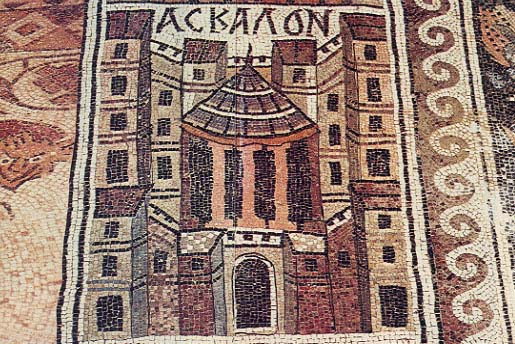
But what of the Arab tradition that this depression is what is left of the Wells of Abraham. Actually, the tradition is also preserved in early Christian sources. The earliest Arab record of the tradition is by the 14th-century writer Ibn Batutah. But long before then, the renowned Wells of Abraham were mentioned by the early Church Fathers Eusebius of Caesarea (260–340 A.D.) and Origen (185/186–254/255 A.D.). The wells were believed to have been dug by the Patriarch himself. As early as the fourth century A.D., Ashkelon was one of the ports of call where Christian pilgrims disembarked. One of the first sites they would have visited was the famous Wells of Abraham. According to Origen, the wells had a “strange and extraordinary style of construction.”9 One of Origen’s contemporaries, Eustathius of Antioch, took Origen to task for his allegorical interpretation of the wells.10 But perhaps Origen’s description of the wells was more accurate than either Eustathius or modern scholars have given him credit for. If there had once been a theater in the hollow, it probably had a parados, or fountain, with water channels that freshened the air of the theater and separated the spectators from the actors. By the fourth century all that remained was a theater in ruins in which a spring (or well) still flowed.”11

One of the impressive buildings second- and third-century visitors to Ashkelon would have seen was the building Garstang misidentified as a combination of King Herod’s peristyle (colonnades, or cloister) and the apsidal Senate Hall (bouleuterion). It was over 350 feet long and about 115 feet wide. In the center was an open, rectangular courtyard, surrounded by a portico with 24 columns on a side. The columns once stood over 25 feet high, including the Corinthian capitals. The columns, sculpture and wall-facing were made of imported marble. On the south side of the building was an apse, over 40 feet in diameter, flanked on both sides by square rooms. Greek inscriptions found nearby mention two Roman citizens, Aulus Iustulius Tances, a centurion of the Tenth Legion, and Tiberius Julius Micio, a citizen of Ashkelon; both were honored by the council (boule

Several marbles found by Garstang—a small white marble statue of a “Crouching Aphrodite” about a foot and a half high; a marble pillar carved in relief depicting the Egyptian goddess Isis flanked by the infant Horus; and two marble pillars depicting Victoria-Nike, goddess of Victory, holding a wreath and a palm and standing full-front on a globe supported on the shoulders of Atlas—have all been identified by Professor Cornelius Vermeule of Boston College and the Boston Museum of Fine Arts as part of a contemporary program of decoration executed during the Severan dynasty, most likely in the first decade of the third century A.D.12
Another equally impressive basilica at Ashkelon was exposed by Lady Hester Stanhope in 1815. She was looking for a treasure hidden at Ashkelon and marked on an Italian monk’s map that had come to her attention. During her treasure hunt she uncovered the basilica as well as a statue of a cuirassed soldier. In order to prove to the Ottoman sultan that she had no interest in taking antiquities home to England, she ordered the statue smashed. Most early commentators assumed that she destroyed the statue in the hope of finding the treasure of Ashkelon buried therein, but this was not the case.b Fortunately, her personal physician, Dr. Charles Lewis Meryon, who traveled with her, made a sketch of the cuirassed statue before it was smashed. His sketch is sufficient to date the statue and the basilica to the Severan period as well.13
After redating the sculpture and the two monumental peristyle buildings (discovered by Stanhope and by Garstang) to the Severan period, I could then see that the organization of Roman Ashkelon bore a striking resemblance to the New Forum, with its civic center and marketplace, which the emperor Septimius Severus (193–211 A.D.) built along the harbor of his birthplace Lepcis (or Leptis) Magna in Tripolitania, North Africa.
Adjacent to the area where Lady Hester Stanhope’s basilica was located, we excavated a villa in Grid 38 (upper) that was part of a distinctly patrician neighborhood. The villa had a marvelous view to the north, overlooking terraced gardens and the large basilica exposed by Lady Hester. In a small room on the north side of the villa, we found hundreds of eggshell-thin sherds that had once been discs of ceramic oil lamps. Some of the larger fragments bore erotic motifs, others had mythological motifs.
The lamps had all been made in molds. None of them had ever been lit; although a terra-cotta bull and a kneeling ceramic camel laden with amphorae were available to fill the lamps with olive oil, there were no soot marks on any of them from burnt wicks. So it is unlikely they were ever used. When the lamps are pieced together perhaps the purpose of the roomful of lamps will become clearer. The room where they were found does front on a small street, but it seems unlikely that oil lamps were being sold from the ground floor of such a patrician villa. Our best guess at the moment is that this collection of erotic and mythological lamps and other notions found in the room was solely for the amusement of the owner.
Lest the reader conclude that the inhabitants of Ashkelon were unusually lascivious, it should be pointed out that similar erotic lamps have been found in every major city in Palestine as well as elsewhere in the empire during the Roman period. Even in Jerusalem, whose name was changed by the Romans in the second century A.D. to Aelia Capitolina, numerous erotic lamps have been uncovered in the excavations led by Professor Benjamin Mazar adjacent to the Temple Mount.14
Based on the distribution of erotic lamps throughout the Roman world, we conclude that the erotic lamps from Ashkelon probably belonged to a Greco-Roman household, rather than to a Jewish or a Christian household. The Romans no doubt thought the lamps sexually titillating and perhaps even arousing.
Roman attitudes toward human sexuality contrasted sharply with contemporaneous Jewish and Christian attitudes, so much so that the presence of lamps depicting both heterosexual and homosexual scenes would have been quite incongruous in a Jewish or a Christian home.
In Roman families, the ideal daughter was expected to enter marriage a virgin and then to remain faithful to her husband throughout marriage. However, a double standard was applied to males. Little or no stigma was attached to sexual affairs before or during marriage, whether with males or females. For freeborn males, premarital and extramarital affairs were socially acceptable so long as they did not violate norms pertaining to power and status in Roman society. It was socially acceptable, for example, for young bachelors, or a married man and a young bachelor, to have sex together. Sexual relations with a person of inferior status, such as a slave or a foreigner or a prostitute, regardless of gender, fell within the boundaries of acceptable behavior. Adultery, involving the wife of another freeborn Roman, did not. Fleeting liaisons, however, should remain discreet and not be confused with much more serious marital relationships.
The dominant status of the Roman male was also expressed in his domineering role in sexual relationships. Sodomy and, to a lesser extent, pederasty were acceptable behavior—as we see from one of the lamps—so long as the older, higher-born male played the active role of sodomist, not catamite. Because of his dominant status and power, it was considered a gross violation of the moral order for a Roman male to perform fellatio or cunnilingus on his sexual partner—just as it was against nature for a woman to behave like a man, or to mount her lover.
By contrast, contemporaneous Jews and Christians adhered to what we would consider a much stricter sexual code, based on Biblical injunctions. Both groups condemned adultery and homosexuality (see, for example, Exodus 20:14; Leviticus 18:22, 20:13; 1 Corinthians 6:9; Romans 1:26–27, 2:22; 1 Timothy 1:10). Fidelity was the key virtue for both husband and wife, without exception. For many Christians in the later Roman period, celibacy was considered the highest form of devotion to God, surpassing even marriage as a virtue, just as it was for St. Paul (although his celibacy should be understood in the context of his expectation of the imminent Parousia, the second coming of Christ at the end-time).
For married couples, both Jewish and Christian, sex was for procreation, not recreation. “Be fruitful and multiply” was the divine blessing (Genesis 1:28). Jews and Christians took a pro-natalist attitude toward conception and children. This attitude must have contributed significantly to prohibitions against homosexual and bisexual behavior. They were adamantly against contraception, abortion and infanticide, whereas the Romans were not, as we shall soon see in the case of infanticide at Ashkelon in the Byzantine period.15
As noted earlier, beneath the heavy veneer of Hellenization and Romanization of Ashkelon, many aspects of the older Oriental culture of the Phoenicians managed to survive. Some of the older religious cults not only survived but actually flourished, especially when they could contribute to, or be incorporated into, the Roman imperial cult. No better example of this phenomenon can be found than the cult of the Phoenician goddess Tanit (mother goddess and virgin bride, consort of Ba’al Hamo
Tanit appears together with Roman emperors and empresses on second- and third-century A.D. coins minted in Ashkelon. Tanit is depicted as a war goddess, brandishing a sword and carrying a shield as well as a palm branch. She is identified in Greek as Phane
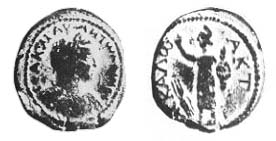
The iconography on these Phane
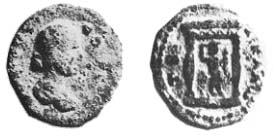
At the age of 15, Elagabalus was elevated to emperor. He reigned barely four years. To prepare the Roman senators for this eccentric Syrian ruler, his mother sent ahead a portrait of the handsome youth, bedecked in his sacerdotal robes dyed in Phoenician purple and embroidered with gold thread. But this was not warning enough for what they were about to experience. In a very short time, he managed to create one scandal after another, even in jaded Rome. In addition to being a religious fanatic of the god Elagabal (whom most Romans had probably never heard of before his devotee’s arrival), the young emperor was also an exhibitionist—his boyish face, with kohl-darkened eyes and heavily rouged cheeks, peering out from under his jeweled crown. Like many other Roman males, Elagabalus was an ardent bisexual. He frequently made the rounds of the public baths of Rome, sizing up prospective male lovers. Promotions to high office and positions of responsibility were more often made to those who displayed sexual prowess or who granted sexual favors than to those who had competence in governmental matters. His protective mother frequented debates in the Senate and presided over a “female senate,” which deliberated about rules of etiquette.18
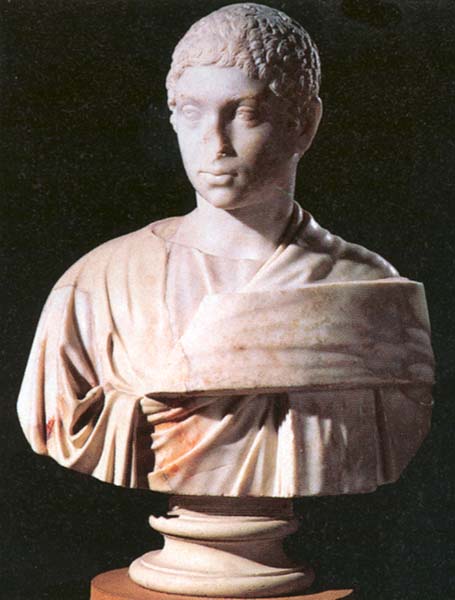
To many Roman senators, the young emperor’s effeminate manner must have been disgusting, and a clear violation of the “macho” code for Roman males. His public processions and rituals for the deity Elagabal were no doubt regarded as bizarre. But most intolerable was his political ineptitude, which ultimately led to his (and his mother’s) downfall. An aunt orchestrated the murder of both the emperor and his mother, bringing his reign to an end in 222 A.D.
But who was this obscure Syrian deity Elagabal from whom the youthful emperor took his throne name and ultimately his identity? During his brief reign, Elagabalus transported his favorite deity’s cult image, a conical “black stone” from Syria, and brought the statue and dowry of the Phoenician goddess Tanit from Carthage. Both were enshrined on the Palatine, and as the divine couple they reigned as the leading deities of Rome. And, of course, therein lies the clue to solving the mystery of the identity of Elagabal; he was none other than Tanit’s spouse in Carthage, the well-known Phoenician (and Syrian) deity Ba’al H
In addition to his forays in the public baths, Emperor Elagabalus married at least four wives during his short reign. One of them was a Vestal Virgin, whom he identified with the goddess Tanit. And, of course, he was Elagabal. Their marriage, then, replicated that of the heavenly couple, Ba’al H
Sometime in the fourth century A.D., a bathhouse was built over some earlier Roman villas in Ashkelon, including the villa where we found the erotic lamps. We can’t yet decide whether this was a small public bath or a large private one. In any event, it had a much-repaired mosaic floor, so it was used for many years. Finally, in the sixth century A.D., the bath was replaced by a monumental apsidal building.
The bathhouse itself underwent at least one remodling. In the early phase, the tub was larger. At each corner was a “heart”-shaped column. (Looking down on it, it was shaped like a heart, where two columns had come together at the corner, like this:  ) These four columns probably supported a canopy over the plastered tub. In the white mosaic floor was a tabula ansata (a rectangle for an inscription with triangles at each end outside the rectangle and pointing toward it, like this:
) These four columns probably supported a canopy over the plastered tub. In the white mosaic floor was a tabula ansata (a rectangle for an inscription with triangles at each end outside the rectangle and pointing toward it, like this:  ). The tabula was outlined with black tesserae; inside the rectangle was an inscription, but unfortunately it was so badly damaged it could not be read. However, in the next phase, when the tub was smaller, another inscription in Greek, also inside a tabula ansata, was written on the outer face of the plaster rim of the tub, just above the spot where the earlier floor inscription had been located. We can surmise that both inscriptions said the same thing. The one on the plastered panel of the tub read in Greek “eiselthe apolauson kai […],” “Enter, enjoy, and…”
). The tabula was outlined with black tesserae; inside the rectangle was an inscription, but unfortunately it was so badly damaged it could not be read. However, in the next phase, when the tub was smaller, another inscription in Greek, also inside a tabula ansata, was written on the outer face of the plaster rim of the tub, just above the spot where the earlier floor inscription had been located. We can surmise that both inscriptions said the same thing. The one on the plastered panel of the tub read in Greek “eiselthe apolauson kai […],” “Enter, enjoy, and…”
At first we thought the bath might also have been a brothel. As we saw in the account of the teenage emperor Elagabalus, public baths, then as today, could serve more than one purpose. We later learned, however, that inscriptions like this were not uncommon in bathhouses during the Roman period, and that they did not have sexual connotations.20 The inscription was simply a warm welcome, whether the bath was public or private.
What was not so warm and friendly was a gruesome discovery in the sewer that ran under the bathhouse. The sewer was large enough for a person to stand up inside it; a gutter ran along its well-plastered bottom. The sewer had been clogged with refuse sometime in the sixth century A.D. When we excavated and dry-sieved the desiccated sewage, we found numerous small bones that we assumed to be animal bones. Only later did we learn from our staff osteologist, Professor Patricia Smith of Hebrew University, that they were human bones—of nearly 100 little babies apparently murdered and thrown into the sewer.
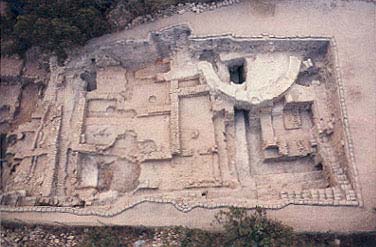
Roman attitudes toward infanticide were quite different from those of Jews and Christians, both of whom, as we noted earlier, were pro-natalist and whose moral teachings forbade the practice. The Greeks and the Romans found infanticide to be the most effective form of birth control.c Abandonment and exposure to the elements and to ravaging animals were the most common method mentioned in classical myths and legends, of course, there was always the possibility that the baby would be rescued and nurtured just as Moses was by the pharaoh’s daughter or Romulus and Remus were by the friendly she-wolf.21 Egyptians, whose religion also forbade infanticide, were allowed to rescue abandoned babies and adopt them as foundlings or rear them as slaves. Greeks and Romans were in the habit of discarding their unwanted infants on manure piles. To memorialize the rescue, Egyptians often gave these babies “copro-” names (such as Kopreus), relating to the dungheap.
Most revealing, though, of the Greco-Roman attitude toward infanticide, is a letter written June 17, 1 B.C., by a certain Hilarion to his pregnant wife, Alis:
“Know that I am still in Alexandria. And do not worry if they all come back and I remain in Alexandria. I ask and beg you to take good care of our baby son, and as soon as I receive payment I will send it up to you. If you are delivered of child [before I get home], if it is a boy keep it, if a girl discard it. You have sent me word, ‘Don’t forget me.’ How can I forget you. I beg you not to worry.”22
What could be more casual (and callous) than this father’s attitude toward the disposal of his newborn daughter?
After Emperor Constantine converted to Christianity and made that the official religion of the empire, a law was put on the books making infanticide illegal. That law, however, failed to deter those fathers and mothers who discarded their newborns in the sewers of Ashkelon. Were most of the helpless victims girls? At the moment physical anthropologists cannot answer that question from skeletal evidence alone. Someday soon, I hope, advances in analytical testing of bone material will provide an answer.
Ashkelon was founded on an underground river. About 15 million years ago it flowed aboveground. But later in prehistoric times, sands from what became the Nile Delta washed up and over the coastal plain of Canaan, forming north-south ridges of loosely cemented sandstone, now the local bedrock known as kurkar. These sands buried the river channel, making it an aquifer, or “drainpipe,” that carries fresh water to the coastal plain, seeping to the surface at several places. Dozens of wells, some of them quite ancient, tap this underground water source 60 feet or more below today’s picnic grounds of the Ashkelon park. In the past, as today, these fresh waters transformed Ashkelon into a veritable oasis and garden spot.
In the Roman period, Ashkelon was famous for its wheat, henna (still used in the Mediterranean as a vegetable dye for hands and hair), dates and onions, which were displayed at international trade fairs in Gaza as well as Ashkelon.23 Ashkelon even lent its name (“Ascalon” in classical sources) to a special variety of onion (caepa Ascalonia) grown there and exported around the Mediterranean to numerous Roman cities.24 We know this onion today as the scallion (after Ascalon). (Although Ashkelon lent its name to the onion, it took its name from the old Northwest Semitic, probably Canaanite, word T

In the fifth to sixth centuries A.D., Ashkelon and Gaza became renowned for their wines.25 Just how widespread the export of wine from this area was is reflected in the pottery vessels used to transport it. Over 15 years ago, a specialist in Roman pottery, Dr. John Riley, put forth the brilliant hypothesis that a certain type of storage jar—a short and very ugly one he designated Type 2—found at Caesarea actually came from the Gaza region and was “either the container or the forerunner of the container for Gaza wine.”26 This type of amphora is found throughout the Mediterranean and in Europe as far northwest as London. Several exemplars have even been found in Trier (Germany) and in the Crimea. The appearance of these jars in the fourth through sixth centuries A.D. matches precisely the period when Byzantine authors mention wine coming from the Gaza region.

Riley also noted that the highest concentrations of his Type 2 amphora had been found in the Gaza region.
When Riley’s exemplars from Caesarea were subjected to petrological analysis, the clay turned out to be from the Gaza area; when compared with a control sample of modern fired clay from Gaza, the clay from the Caesarea amphorae proved to have a similar texture and composition. This confirmed that the Caesarea amphorae had indeed come from the Gaza area.
Our excavations at Ashkelon have now confirmed that these storage jars were used as transport amphorae for exporting local wines.27 Dr. Barbara Johnson, our staff ceramist and director of the Ashkelon Laboratory in Jerusalem, has studied literally hundreds of thousands of potsherds from the fourth to sixth centuries A.D. recovered in our excavations. A very high percentage of these sherds comes from so-called Gaza-type—perhaps, now, we should add Ashkelon-type—wine jars.
Ashkelon was clearly an important center for the production of these amphorae. In and around construction sites in the modern city of Ashkelon, Frank Koucky has found several kilns in which these ancient vessels had been fired. In addition, in his systematic archaeological survey of the Ashkelon region, Mitchell Allen of UCLA has discovered numerous kilns for producing these amphorae along the sandstone ridges east of the city. Some of these kilns were found in association with wine presses and other buildings, probably components of agricultural estates in the vicinity.28 The wine presses provide another piece of evidence supporting the suggestion that-these transport amphorae should indeed be linked to the wine trade. The coastal region of southern Palestine from south of Gaza north to Ashdod is dotted with manufacturing sites for these storage jars.29
This period—the early Byzantine period—was an especially prosperous one in Palestine. Indeed, it was not exceeded until modern times. The population also reached unprecedented heights, unexceeded until the 20th century. Even the desert—east of the southern coastal plain—bloomed, not because of climatic changes, but because of the economic boom. The export of native wines undoubtedly propelled and sustained the boom. Numerous wine presses, some quite large and elaborate, have been found in the Negev desert at cities such as Shivtah, Avdat and Elusa.30 The demand for these wines was apparently so great that even marginal zones, such as the desert, were worth cultivating by floodwater and runoff techniques of irrigation to produce wine grapes.
Why was there such a demand for wines from Ashkelon, Gaza and elsewhere in Palestine—a demand never equaled before or since? The answer lies, at least in part, in the broader historical picture of the Holy Land in the fourth to sixth centuries A.D.
In 324 A.D. the emperor Constantine officially recognized Christianity. By the late fourth and early fifth centuries A.D., monastic life was flourishing near Gaza and Ashkelon as well as in the Judean Desert. Christianity spread not only into the desert but also in the major cities of Palestine.
Christian pilgrims began to flock to the Holy Land from around the world. From Europe they came in ships that departed regularly from Gaul and Italy, usually sailing via Antioch or Alexandria.
Jerusalem, the holy city, and especially the Holy Sepulchre, were of course primary objectives for these early pilgrims for whom the “testimony of the holy places [was] to substantiate the testimony of the Bible.”31 But they also visited other sacred sites—Bethlehem, Mamre (Hebron), Mt. Sinai (St. Catherine’s Monastery) and even Mt. Ararat, where according to the church historian Eusebius “Noah’s Ark” was still visible.32 No doubt they also wanted to see the “Wells of Abraham” at Ashkelon, as mentioned by Origen. For many Western pilgrims, Ashkelon was their first port of call in the Holy Land. Of all the coastal cities south of Jaffa, only Ashkelon actually sits on the seacoast.
These early pilgrims took home with them all sorts of relics and sacred souvenirs—pieces of the Cross, saints’ remains, fruit from the “garden of John the Baptist,” soil and olive oil used to light lamps at the Holy Sepulchre. The oil was exported in small vials or flasks called ampullae; several examples have turned up in our excavations. According to the anonymous sixth-century Pilgrim of Piacenza, who left us his travel notes, the holy oil was sanctified by bringing the flasks in contact with the wood of the Cross, at which time the oil boiled so furiously that the ampullae popped their stoppers. These had to be immediately replaced to prevent the precious oil from spilling out.33
Like tourists today, pilgrims contributed greatly to the economy of the Holy Land. The relics and souvenirs they brought back must have made a stirring impression on those who could not make, or could not afford, the pilgrimage. There was, however, another commodity, not so easily carried home but apparently also in great demand: wine from the Holy Land, especially wine from the Gaza and Ashkelon regions. It must have been exported in quantity to meet the needs of the churches of Europe. In one sixth-century reference, Gaza wine was bequeathed to a church in Lyons to celebrate the Eucharist.34
Ashkelon was an importer as well as an exporter. Barbara Johnson has identified more than 130 different types of transport amphorae found in our excavations that reached Ashkelon from Spain, Italy, North Africa, Crete, the Aegean and the Black Sea area. This is in addition to more than 30 different types of fine wares, including lovely Cypriot, Italian, African Red Slip (Carthaginian), Egyptian and Coptic tablewares.
Thus, the economy boomed as never before. All this a reflection of pilgrimage to the Holy Land—big business, then as now.
In the seventh century A.D. many parts of the Byzantine empire surrendered to the armies of a powerful new religion—Islam. Ashkelon surrendered to the second Caliph of Islam, Omar, in 636, but the Byzantines did not actually evacuate the city until 640. According to the Arab chroniclers, Ashkelon became a beautiful and delightful city once again. Except for pockets of Omayyad pottery in later fills, however, our excavations have not yet recovered significant remains from this period.
In the Fatimid period (10th–12th centuries A.D.), lovely houses were built along narrow streets; each had a small pool in the courtyard. In the destruction debris and fill next to one of these houses, we recovered four pieces of exquisite 22-karat gold jewelry. Professor Myriam Rosen-Ayalon of the Hebrew University, an expert on Islamic archaeology—and jewelry in particular—found that all four pieces fit together perfectly and belonged to the same larger ensemble; probably the gold pieces were once attached to a soft textile, such as suede or velvet, which was worn as a belt or sash. Each of the four pieces used the same manufacturing technique, combining filigree and granulation, to which gold beads were then added. We marveled at the extraordinary craftsmanship and intricate decorative design—paisley, almond-shaped, S-shaped and heart-shaped motifs.35
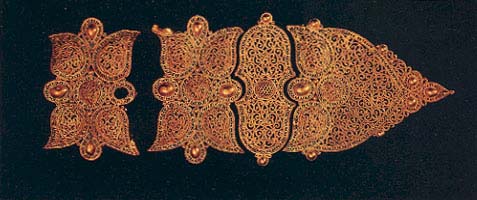
During the Fatimid period the fortifications of Ashkelon were rebuilt—for the last time on a grand scale.36 The earliest ramparts had been built by the Canaanites in the Middle Bronze Age II (2000–1550 B.C.). Much of this Canaanite fortification was incorporated into the Fatimid ramparts. Some of the ruined Fatimid ramparts still rise like giant stalagmites around the rim of the last Islamic city. In the Sea Wall rising above the beach, the Fatimids used old Roman columns made of Aswan granite to reinforce their stone and cement masonry. The old Roman columns look like ships’ cannons sticking out of the Fatimid wall. More Roman columns by the hundreds, if not thousands, lie buried just under the beach sands. They were originally shipped from Egypt to Ashkelon during the Roman period and then reused throughout the next millennium.
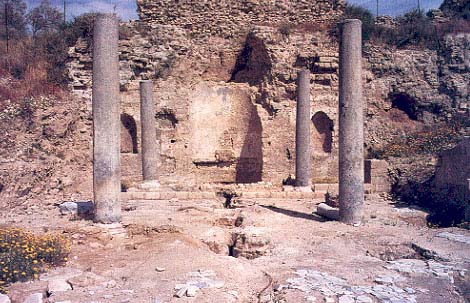
In the 12th century A.D., William of Tyre visited Ashkelon and wrote the following vivid description of its defenses:
“[Ashkelon] lies upon the seacoast in the form of a semicircle, the chord or diameter of which extends along the shore while the arc or bow lies on the land looking toward the east. The entire city rests in a basin, as it were, sloping to the sea and is surrounded on all sides by artificial mounds, upon which rise the walls with towers at frequent intervals. The whole is built of solid masonry, held together by cement which is harder than stone. The walls are wide, of goodly thickness and proportionate height. The city is furthermore encircled by outworks built with the same solidity and most carefully fortified. There are four gates in the circuit of the wall, strongly defended by lofty and massive towers.
“The first of these, facing east, is called the Greater Gate and sometimes the Gate of Jerusalem, because it faces toward the Holy City. It is surmounted by two very lofty towers which serve as a strong protection for the city below. In the barbican before this gate are three or four smaller gates which one passes to the main entrance by various winding ways. The second gate faces the west. It is called the Sea Gate, because through it people have egress to the sea. The third to the south looks toward the city of Gaza…, whence it takes its name. The fourth with outlook toward the north is called the Gate of Jaffa, from the neighbouring city which lies on this same coast.”37
Ashkelon’s Moslem rulers were apparently not as hostile to the two other great monotheistic faiths, Judaism and Christianity, as we might suppose, for we know that Jews continued to reside in Ashkelon throughout the Islamic and Crusader periods. And a Byzantine church, which we excavated in 1985, continued in use throughout most of the medieval period.
During the Crusader period this little church, located just inside and to the south of the Jerusalem Gate, was known as Saint Mary the Green (Santa Maria Viridis).38

Originally, in the fifth century, the church was laid out as a basilica, divided into three aisles by two rows of columns made of Aswan granite (imported earlier in the Roman period and reused). The columns supported a gallery and a pitched roof. As we have seen, the basilica plan was used for both secular and sacred architecture during the Roman period at Ashkelon. When the basilica plan was adopted by church architects, the apse was nearly always oriented toward the Holy City, Jerusalem. Thus the apse of our church was located at the east end of the building, next to the city wall. From the apse, water flowed through a lead pipe and settling basin before reaching a marble-lined cruciform baptistry built into the earliest marble floor. The small size and shallowness of the baptistry would indicate that baptism was by sprinkling rather than by immersion.
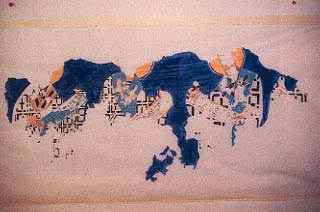
Santa Maria Viridis continued in use throughout much of the Islamic period until the Fatimids converted it to a mosque in the mid-tenth century. It was restored again as a Byzantine church when the Crusaders conquered Ashkelon. Its plan changed, however: only four of the original six columns were used, suggesting a cruciform vaulted ceiling above the apse. Frescoes were added to the central apse and two side niches. Above the robbed-out bench and bishop’s chair (cathedra) in the central apse were frescoes of four saints/bishops reading Greek scrolls, each scroll containing excerpts from the homilies of St. John Chrysostom (the “golden-mouthed” bishop of Constantinople, 398–407 A.D.), as recognized immediately by our staff epigraphist for Greek and Latin, Vasilios Tzaferis of the Israel Antiquities Authority.
Santa Maria Viridis attests not only to the continual presence of a community of Byzantine Christians (sometimes referred to as Oriental, or Syrian, Christians) at Ashkelon from the time of its founding—about 400 A.D.—through the Crusader period, but its architectural history reflects in microcosm the fortunes of the Christian and Muslim political and religious empires during eight centuries (c. 400–1200 A.D.) of competition for the soul of Ashkelon and of the world.
The Fatimids dominated Ashkelon until 1153, when the Crusaders conquered the city. Saladin, the great sultan and commander, regained Ashkelon in 1187. But the Crusaders once again conquered the city in 1191; however, before they did so Saladin himself reduced the great seaport to rubble. The agony and pathos of this self-destruction were poignantly recorded in several Arabic sources. Here is the evidence of one writer; the quotation begins after the Crusaders have captured both Acre and Jaffa and are on their way to attack Ashkelon:
“[Saladin was] informed that [the Crusaders] were determined to rebuild Jaffa and strengthen it with soldiers and equipment. He, therefore, convened his advisers and consulted them about Ascalon: whether the right thing to do was to destroy it or not. They agreed upon its destruction for fear lest the enemy would reach it and occupy it, and by means of it he would occupy Jerusalem, and at the same time would cut off the road to Egypt. [As a result of that decision, Saladin] left his brother al-Malik al-’Adil [Abu Bakr] to face the enemy, and he himself went to destroy Ascalon on the dawn of Wednesday, the 18th of Sha’ban 387 [September 11, 1191].
“It was a very painful thing for him. He said: ‘I would rather be bereaved of all my children than destroy a single stone of it. But if God foreordained anything, it is bound to be carried out.’ He started destroying it on the dawn of Thursday, the 19th of Sha’ban [September 12, 1191]. He divided the wall [among the members of his army] and gave each commander and each group of the army a certain section and a certain tower to destroy.
“The people entered the town crying and clamoring. Ascalon was a town likable to the heart, with firm walls and mighty structures, which people liked to inhabit. The people of the town were deeply saddened and wailed strongly because of the town’s destruction, and because of their having to leave their homeland…
“The Sultan and his sons exerted themselves tremendously in ruining the town, with the purpose that the enemy would not get wind [of the operation], and rush to the town to prevent its destruction. The people [i.e., those who carried out the destruction] were at that night very hard and very exhausted because of what they had endured in the town’s destruction.
“A person sent by al-Malik al-’Adil informed [the Sultan] that the Franks discussed with him terms of a settlement, by which the Muslims would have to cede certain lands [towns]. The Sultan found advantage in it [in the proposed settlement agreement], for he knew how much the people were fed up with war and how heavy were their debts. He gave written permission to his brother to that effect, allowing him to conclude a settlement according to his lights.
“In the meantime destruction and the mobilization of people [for that purpose] went on, with the Sultan urging them to accelerate that operation. He also let them take whatever there had been in the royal granaries out of fear of the Frankish attack and the inability to move away their contents. He ordered the town set on fire, and fires were set in its houses. The town was an immense fortress. Destruction continued without stop until the last day of Sha’ban of that year [September 21, 1191]. When the destruction and burning were completed, the Sultan left Ascalon.”39
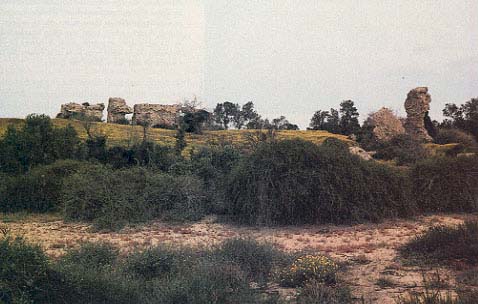
We found considerable evidence of Saladin’s 1191 destruction in many parts of Ashkelon. Near the Jerusalem Gate we found undermined and uprooted towers; the gold jewelry next to the Fatimid houses had been buried in destruction debris. On the beach and underwater, we found Roman columns and other debris that Saladin’s men had used to fill in the medieval harbor, thus rendering it unusable for the Crusaders.
With the demolition of Ashkelon, Saladin initiated a policy of systematically destroying seaports all along the Mediterranean coast—seaports recaptured from the Crusaders. Never again would these seaports fall into Christian hands in usable condition should there be a renewal of the Crusades.
European naval dominance eventually changed the face of the globe. In searching for the safest and least expensive routes to India in the late 15th century, western Europeans avoided overland routes across vast tracts of Moslem territory. Instead, they sailed, for example, around the Cape of Good Hope. They also sought to reach India by sailing west. And this of course led, quite accidentally, to the discovery of America.
Thus the demolition of Ashkelon, when put in its proper historical perspective, becomes a crucial facet of international power politics, the effects of which continue to be felt to this day.
As director of the excavations at Ashkelon, I owe so much to so many: First and foremost, to Ms. Shelby White and Leon Levy, our benefactors, whose intellectual involvement and generous financial support have made this long-term, large-scale project possible; to the Israel Antiquities Authority, its director, Amir Drori, and former director, Avi Eitan, who have facilitated and expedited the research; to Professors Benjamin Mazar and Philip J. King for their wise counsel, to the citizens of Ashkelon and their mayor, the Honorable Eli Dayan, for their boundless hospitality to the hundreds of volunteers for participating in the dig and field school, and to their teachers and supervisors, the professional staff, for bringing Ashkelon’s heritage to light. In addition to staff already mentioned in the text and credits, I would like to thank several senior staff members for their contributions to this multidisciplinary effort: Douglas Esse (former associate director), Moshe (“Musa”) Shimoni (majordomo), Larry and Dorothy Ingalls and Samuel Wolff (administrators and supervisors), Giora Solar and Benny Arubas (architects-draftsmen), Elizabeth Bloch-Smith, David Stacey, Ross Voss, Bill Griswold, Ron Tappy, Jonathan Elias (grid supervisors), Jane Waldbaum (supervisor and classical archaeologist), Charles Adelman and Joelle Cohen (ceramists), Barbara Hall and Valentine Talland (conservators), Ora Mazar (pottery restorer), Heather Campbell and Nicole Logan (registrars), Richard Saley (computer programmer), Ya’akov Meshorer and Haim Gitler (numismnasts), Raphael Ventura (Egyptologist), Bill Grantham (zooarchaeologist), Mordechai Kislev (paleobotanist), Ya’akov Nir (hydrologist) and the late Hanan Lernau (paleoichthyologist). And finally, I want to express my indebtedness to Hershel Shanks, editor, and Steven Feldman, assistant editor, for their many contributions to this series on Ashkelon.
Correction: The photo of the laurel-leaf crown in “Why Were Hundreds of Dogs Buried at Ashkelon,” BAR 17:03, should have been credited to Ilan Sztulman.
MLA Citation
Footnotes
The so-called Letter of Aristeas is really a lengthy discourse in the tradition of Hellenistic literature. The author Aristeas (probably a pseudonym) provides the classic view concerning how the Torah (or the Pentateuch) was translated from Hebrew into Greek in just 72 days by 72 elders brought to Alexandria at the behest of Ptolemy Philadelphus (283–246 B.C.); this translation of the first five books of the Hebrew Bible was called the septuagint (LXX), but the term was later extended to include all of the Hebrew Bible translated at various times into Greek. See Leonard J. Greenspoon, “Mission to Alexandria Truth and Legend About the Creation of the Septuagint, the First Bible Translation,” Bible Review, August 1989.
See Neil A. Silberman, “Restoring the Reputation of Lady Hester Lucy Stanhope,” BAR 10:04.
See Lawrence E. Stager and Samuel R. Wolff, “Child Sacrifice at Carthage—Religious Rite or Population Control?” BAR 10:01.
Endnotes
Ya’akov Meshorer, City Coins of Eretz-Israel and the Decapolis in the Roman Period (Jerusalem: Israel Museum, 1985), p. 26.
Shimon Applebaum, “Economic Life in Palestine,” in The Jewish People in the First Century, ed. S. Safrai and M. Stern (Philadelphia: Fortress, 1976), vol. 2, p. 688 and n. 10, with reference to inscriptions nos. 1717–1724 and 2283 from Delos (in Launey and Roussel, Inscriptions de Delos [1937]).
“Letter of Aristeas,” line 115, in John R. Bartlett, Jews in the Hellenistic World, Cambridge Commentaries on Writings of the Jewish & Christian World 200 BC to AD 200 (Cambridge, UK: Cambridge Univ. Press, 1985), vol. I, part 1, p. 27.
David Flusser, “Paganism in Palestine,” in Safrai and Stern, The Jewish People in the First Century vol. 2, p. 1099.
On the authority of Julius Africanus (c. 170–243 A.D., cited in Eusebius, Ecclesiastical History Bk. I 6.2, 7.11). See Eusebius, The History of the Church, transl. G.A. Williamson (New York: Dorset, 1965), pp. 51, 55.
E.D. Hunt, Holy Land Pilgrimage in the Later Roman Empire AD 312–460 (Oxford Clarendon, 1984), p. 93 and n. 54, citing Origen, Contra Celsum 4.44 and Eusebius, Onomasticon, 168.
Hunt, Holy Land Pilgrimage, p. 93, n. 55, Citing Eustathius, De Engastrimytho 21 (ed. E. Klostermann, Kleine Texte 83 [1912]).
This reconstruction of the evidence allows us to make sense of some other texts that mention the Wells of Abraham. Ibn Batutah observes that “you descend to these [Wells of Abraham] by broad steps leading to a chamber. On all four sides of the chamber are springs of water gushing out from the stone conduits.” Antoninus Martyr, writing c. 560 A.D., describes the Well of Peace (Puteus Pacis) at Ashkelon in similar words: “There is a Well of Peace made after the manner of a theater, in which one descends by steps into the water.” Garstang mistakenly located the Well of Peace in the apse of the large basilica, i.e., in his putative bouleuterion. Of course, when he completed the excavations in the apse, there was no well to be found. The Well of Peace is just another name for the Wells of Abraham or the Bir Ibrahim. And it is now clear that Origen, Antoninus Martyr and Ibn Batutah were describing all that remained of the Greco-Roman the water: “wells” noted for “their strange and extraordinary style of construction” and “built after the manner of a theater.” Compare, for example, John Garstang, “The Fund’s Excavation of Askalon” Palestine Exploration Quarterly (PEQ) 21 (1921), pp. 14–16; “The Excavations at Askelon,” PEQ 22 (1922), pp. 112–117; “Askalon,” PEQ 24 (1924), pp. 24–35.
Cornelius Vermenle, “Askalon,” in M News (Boston: Museum of the Fine Arts, 1991), pp. 85–89, Vermeule and Kristin Anderson, “Greek and Roman Sculpture in the Holy Land,” in Burlington Magazine, 1981, pp. 7–20. Vermeule believes the sculpture excavated from the Severan basilica represents the “most splendid Roman imperial architectural sculpture to be found east of Ephesus and Corinth,” p. 15.
See Charles L. Meryon, Travels of Lady Hester Stanhope, from the Completion of Her Memoirs, Narrated by Her Physician, vol. 3 (1846), p. 162. From his drawing one can see the Gorgoneion in the center of the breastplate, with two griffins flanking some object below. A twin of the Ashkelon statue was recently excavated in Roman Beth-Shean—a larger-than-life-size marble statue (head missing) of a cuirassed soldier, probably an emperor, with the same motifs on the breastplate (for a photo, see “Glorious Beth-Shean,” BAR 16:04).
Unfortunately, Lady Hester Stanhope’s basilica has been pillaged of all its masonry. However, Frank Koucky would locate it in an area that today is a parking lot for visitors to the beach, below the north slope of the south mound (al-Hadra) and just north of Grid 38 (lower). He could do this because of the detailed and accurate rendition of buildings and monuments of Ashkelon published in 1855 by David Roberts, as viewed from a perspective on the north mound looking south.
For an excellent discussion of the differences between Greco-Roman and Christian sexual codes and the ideal conduct during the second to fourth centuries A.D., see Robin Lane Fox, Pagans and Christians (New York: Knopf, 1987), especially chapter 7, aptly titled “Living Like Angels,” pp. 336–374. Also see Paul Veyne, “Homosexuality in Ancient Rome,” in Western Sexuality: Practice and Precept in Past and Present Times, ed. Philippe Ariès and André Béjin; transl. Anthony Forester (Oxford: Basil Blackwell, 1985), pp. 26–35.
It is the same type of epithet as Astarte’s s
Actually it is a series of doorways, each a bit smaller, reaching all the way to the inner sanctum, or holy of holiest. The outermost doorway and facade (also the largest) is flanked by columns supporting a disc and crescent (symbol of either Tanit or Ba’al H
See “Elagabalus,” in The Oxford Classical Dictionary, ed. N.G.L. Hammond and H.H. Scullard (Oxford: Clarendon, 2nd ed., 1970), p. 377.
For Ba’al H
See John Boswell, The Kindness of Strangers—The Abandonment of Children in Western Europe from Late Antiquity to the Renaissance (New York: Pantheon, 1988). He is more sanguine than I am about the prospects of exposed infants and children being rescued.
Michael Avi-Yonah, The Holy Land: From the Persian to the Arab Conquest (536 B.C.–A.D. 640) (Grand Rapids, MI: Baker Book House, 1977), pp. 195–196, and Applebaum, “Economic Life in Palestine,” p. 648.
John A. Riley, “The Pottery from the First Session of Excavation in the Caesarea Hippodrome,” Bulletin of the American Schools of Oriental Research, p. 30, n. 20.
Ann Killebrew of the Hebrew University has added another type of amphora (her Type A found at Deir el-Balah) to the repertoire of so-called Gaza wine jars. Our results at Ashkelon confirm her suggestion.
Mitchell Allen, “The Ashkelon Regional Archaeological Survey.” Paper presented at the national AIA convention in San Francisco, December, 1990. This research will soon appear as part of his Ph.D. dissertation being completed at the Institute of Archaeology, UCLA.
See Ann Killebrew’s chapter on Roman and Byzantine pottery, final report of the excavations at Deir el-Balah (forthcoming).
Philip Mayerson, “The Pilgrim Routes to Mount Sinai and the Armenians,” Israel Exploration Journal 32 (1982), pp. 44–57, for Ararat, see Eusebius’ Onomasticon 2–4, ed. E. Klostermann, Die griechischen christlichen Schriftstellar der ersten drei Jahrhunderte (Leipzig 1904, reprinted 1966).
Myriam Rosen-Ayalon, “The Islamic Jewellery from Ashkelon,” in Jewellery and Goldsmithing in the Islamic World, An International Symposium, Jerusalem, ed. Na’ama Brosh (Jerusalem: Israel Museum, 1991), pp. 9–20.
William of Tyre, A History of Deeds Done Beyond the Sea, transl. E.A. Babcock and A.C. Krey (New York: Columbia Univ. Press, 1943), pp. 17, 22. For a very readable account of Ashkelon in the Crusader period, see Meron Benvenisti, The Crusaders in the Holy Land (Jerusalem: Israel Universities Press), pp. 114–130.
We know this because of the five churches at Ashkelon during the time of the Crusaders, four were Latin and one was Byzantine (Greek), namely, Santa Maria Viridis. Before our excavations scholars usually thought this church was located next to the sea (in Grid 50), near a Muslim saint’s tomb known as Maqam al-Hadra, or Shrine of the Green (Lady), from which the south mound took its name. We now know that the church was located on the opposite side of the city.
David Ayalon “The Mamluks and Naval Power—a Phase of the Struggle between Islam and Christian Europe,” Proceedings of the Israel Academy of Sciences and Humanities, vol. I (Jerusalem, 1965), pp. 1–12. Also “Islam versus Christian Europe: the Case of the Holy Land,” in Pillars of Smoke and Fire: the Holy Land in History and Thought, ed. Moshe Sharon (Johannesburg, 1988), pp. 247–256.


